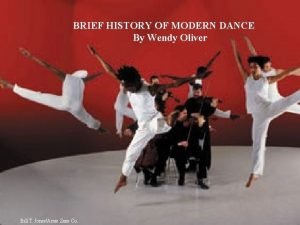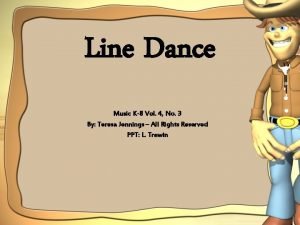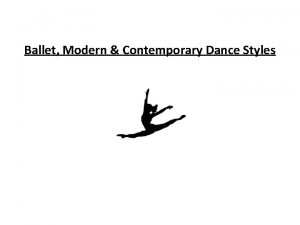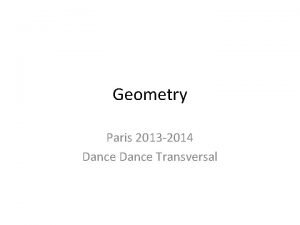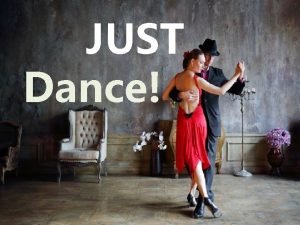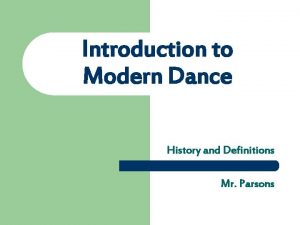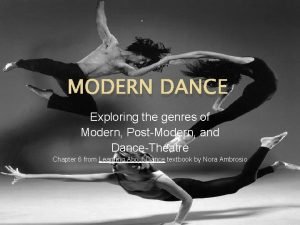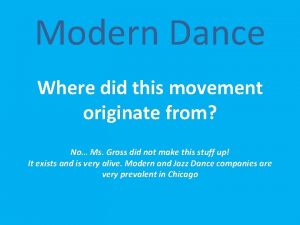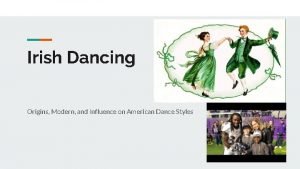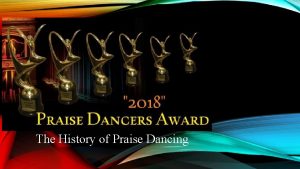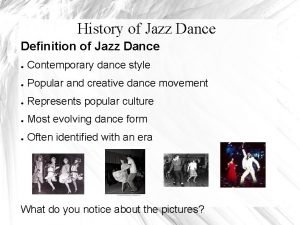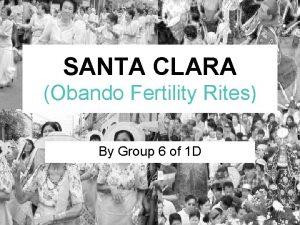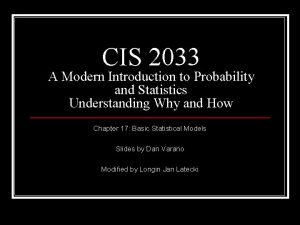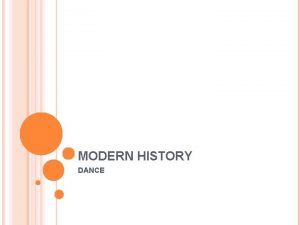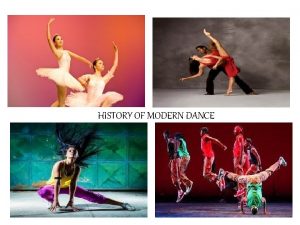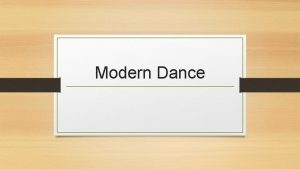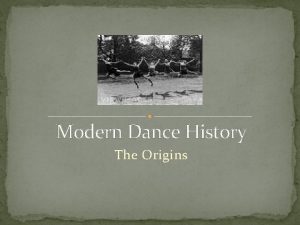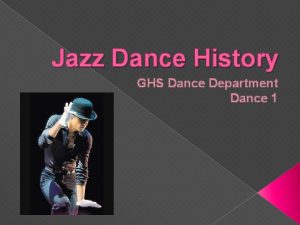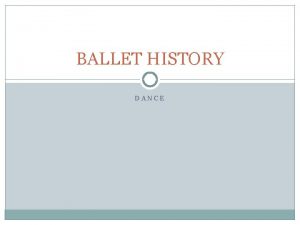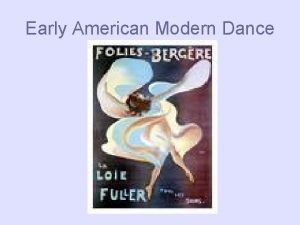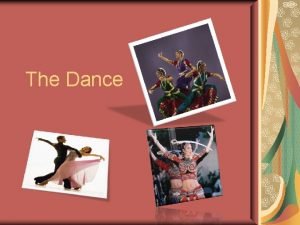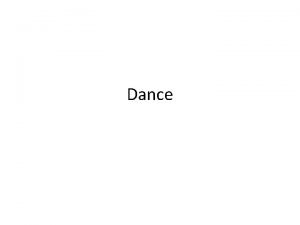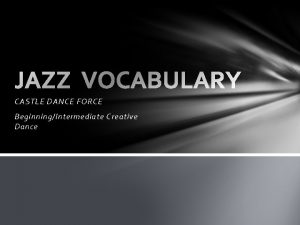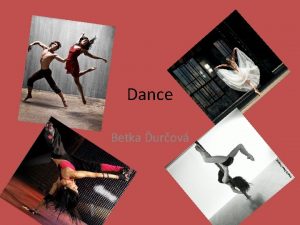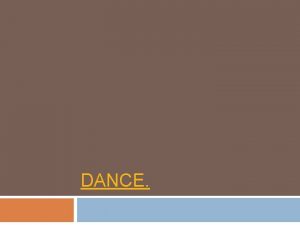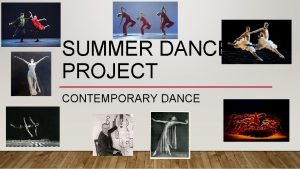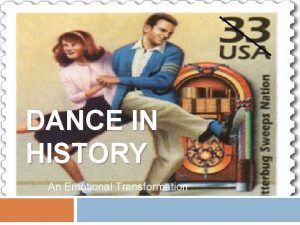Introduction to Modern Dance History and Definitions Mr




















- Slides: 20

Introduction to Modern Dance History and Definitions Mr. Parsons

The Purpose of Modern Dance l Modern stemmed from a rebellion against traditional ballet and a rejection to ballet. – – l Ballet: Rejected the strictness of the body, the unnatural lines and strict training, and the hierarchy found in most ballet schools. Vaudeville: Rejected the “offensive exhibitionism. ” Modern dance could make people think about real life and not about fantasies or fairytales. Dance could be social commentary; it could lead to political change.

Characteristics of Modern Dance l l l l No set curriculum No regular set of exercises No particular music No particular costume No particular body type No fancy music or scenery However, you will typically see parallel position and bare feet in modern classes.

Phases of Modern Dance “Free Dance” Late-1800 s - early 1900 s

Modern: The “New Dance” l l Social, economic and political changes raised new questions about morality, rights, freedom and the human condition as well as questions about the purpose behind art. This new dance was not traditionally beautiful to the accustomed fine arts patron. In fact, it often looked like improvisation. Dance began focusing on the expression of the artist rather than entertaining and appealing to the audience.

Isadora Duncan (1877 -1927) l l Known as the “Mother of Modern Dance. ” Believed ballet was "ugly and against nature. “ Founded her “Free Dance” of interpretive dance, blending poetry, music and rhythms of nature. She danced barefoot with her hair down and flowing in simple Greek apparel. . Though an American, she traveled Europe and was not popular in the U. S. during her life.

Loie Fuller (1862 -1928) l l Known as the “Goddess of Light. ” Choreographed natural movement and used improvisation techniques with silk costumes illuminated by multi colored lighting.

Phases of Modern Dance “The Big Four” Modern Dance Pioneers Early 1900 s - mid-1900 s

Martha Graham (1894 -1991) l l l Graham developed the principle of contract and release. Her style focused on muscular control and appeared jarring to many viewers. Founded the first Bachelor of Arts Degree in Dance. Founded the Martha Graham Dance Co. in 1926. Famous students include: – – Paul Taylor Merce Cunningham

Doris Humphrey (1895 -1985) l l l Created the principle of fall and recovery. Humphrey was a leading soloist in Denishawn. Created the Humphrey. Weidman school and company with Charles Weidman.

Phases of Modern Dance The Second Generation & Post-Modernism 1940 s – 1980 s

The Second Generation l l This is the time period when students of the Big Four struck out on their own. The Big Four used these students to develop their own techniques and then the students broke out. This resulted in more development and exploration of modern techniques & form. These techniques are still performed today.

Paul Taylor (1930 -present) l l l Uses everyday gestures and modernist ideology. Creator of the Paul Taylor Dance Company and Taylor 2. Danced for Merce Cunningham, Martha Graham and George Balanchine.

Postmodernism (1960 s-1970 s) l l l The postmodernists (“after-moderns”) rejected the techniques and theories of modern dance and experimented with new movement structures. Claimed that any movement (even every day pedestrian movement) was dance, and any person was a dancer (with or without training) Chance dance, happenings, contact improvisation, dance theatre and performance art were brought back from the early 1900’s.

Phases of Modern Dance Contemporary Dance & Internationalism Late 1900 s - present

Contemporary Dance (1970 s-present) l l “Anything Goes” contemporary Dance is a melting pot of modern, post-modern and other dance styles. Internationalism: contemporary concert dance has no national face and no particular cultural face.

Alvin Ailey (1931 -1989) l l l Inspired by gospel, spirituals and the blues. Ailey's dances fuse modern with elements of jazz, ballet, and African dance, and draw heavily upon African. American themes. Created Alvin Ailey American Dance Theatre in 1958; the company gave exposure to many African-American and Asian dancers. Revelations is his most critically acclaimed work.

Twyla Tharp (1941 -present) l l Danced for Paul Taylor. Created Twyla Tharp Dance. Choreographer for numerous broadway shows, hollywood movies. In 1988, Twyla Tharp Dance merged with American Ballet Theatre.

Mark Morris (1956 -present) l l l Has earned a reputation as “the bad boy of modern dance. ” Known for his musicality, use of ballet and social dances, craftsmanship, ingenuity, humor, and at times diverse music choices, Morris is popular among dance lovers and mainstream audiences. . http: //www. pbs. org/newshour/bb/entertainment/markmorris/ind ex. html

Important terms l Most modern dance is done barefootlike the popular show So you think you can dance. l l A choreographer is the person who makes up the dances. A mixed bill is not a full length work but a selection of smaller works.
 Dance dance dance in the freedom we know
Dance dance dance in the freedom we know History of modern dance
History of modern dance Cha che slide
Cha che slide Everybody dance and sing line dance
Everybody dance and sing line dance Characteristic of modern
Characteristic of modern Ballet positions names
Ballet positions names Dance dance transversal
Dance dance transversal Inequalities warm up
Inequalities warm up Just dance irish dance
Just dance irish dance Match the following terms with the correct definitions
Match the following terms with the correct definitions Characteristics of modern dance
Characteristics of modern dance Post modern dance
Post modern dance Where did modern dance come from
Where did modern dance come from Characteristics of jazz dance
Characteristics of jazz dance Origin of riverdance
Origin of riverdance Where did praise dancing come from
Where did praise dancing come from Characteristics of jazz dance
Characteristics of jazz dance Obando fertility rite
Obando fertility rite A modern introduction to probability and statistics
A modern introduction to probability and statistics Sugar industry in hawaii timeline
Sugar industry in hawaii timeline Egyptian floral design time period
Egyptian floral design time period

